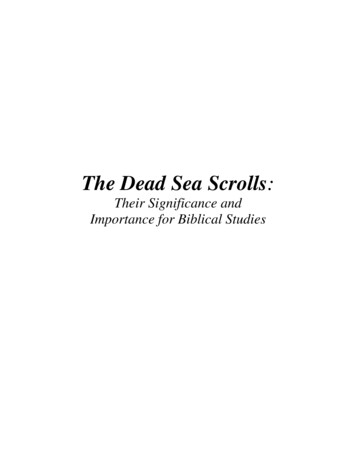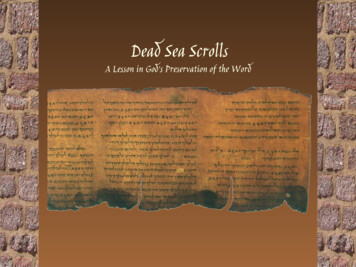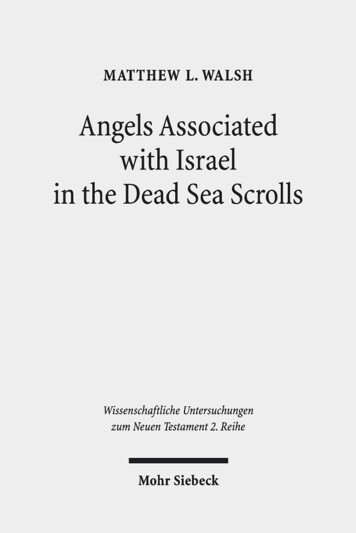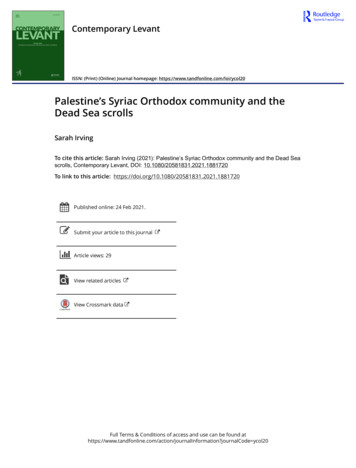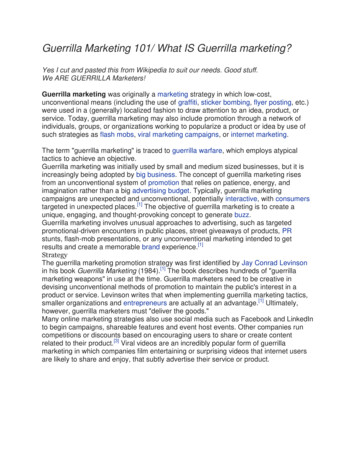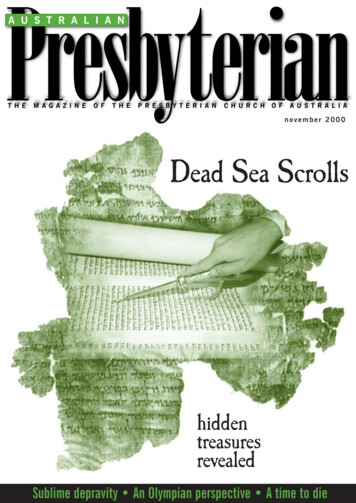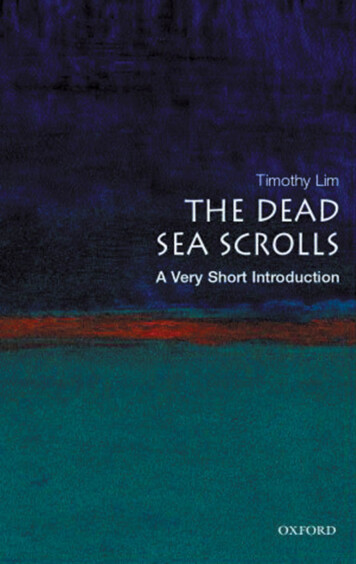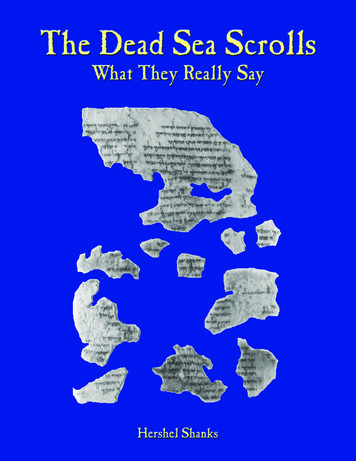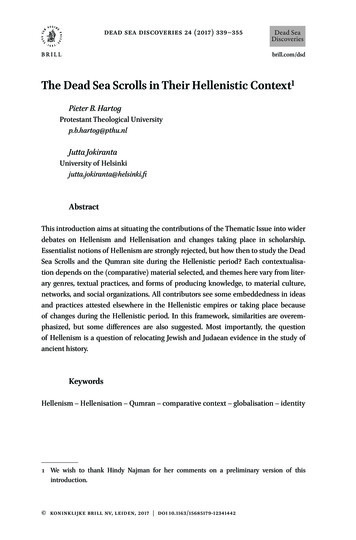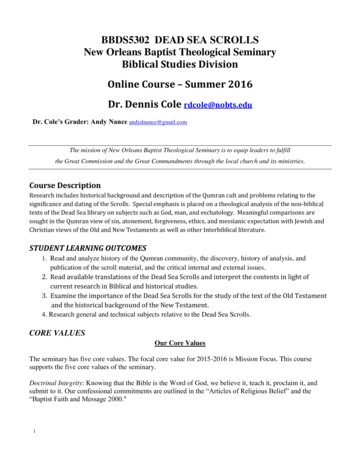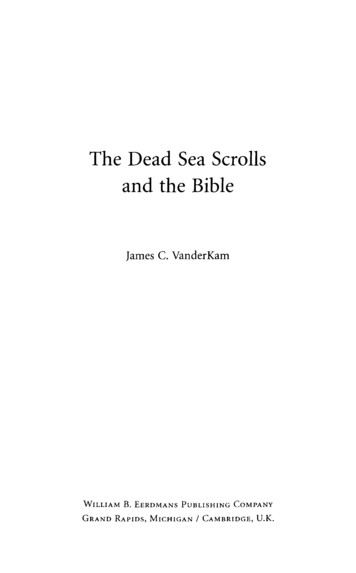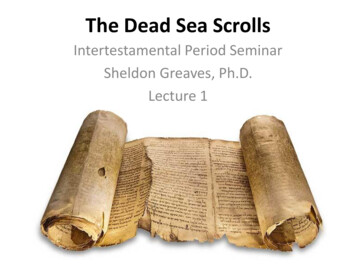
Transcription
The Dead Sea ScrollsIntertestamental Period SeminarSheldon Greaves, Ph.D.Lecture 1
Some Changes Would like to draw more on what we’vestudied in the seminar up to now Integrate the seminar with efforts to create anorganization that promotes the idea ofScholars-in-Residence Produce some artifact that would assist othersinterested in the subject.
www.lafkospress.com
What Are the Dead Sea Scrolls? Regarded as one of the major archaeologicaldiscoveries of the 20th Century Over 800 parchment manuscripts, mostlybiblical texts Copies of multiple previously unknown works Discovered hidden in caves near the NW shoreof the Dead Sea Written mostly in Hebrew, plus some Aramaicand a few Greek texts
Why Are They Important? The oldest Hebrew copies of the Old Testamentbooks (except for Esther) yet discovered,predating previous manuscripts by over 1,000years. New light on the Jewish Essene sect, up to nowknown mainly through a few scattered referencesin late classical historians A wealth of details about the religious andcultural background behind the emergence ofChristianity.
Scholars will recall that several years ago ashepherd wandering in the Gulf of Aqabastumbled upon a cave containing several largeclay jars and two tickets to the ice show. Insidethe jars were discovered six parchment scrollswith ancient, incomprehensible writing whichthe shepherd, in his ignorance, sold to themuseum for 750,000 apiece. Two years laterthe jars turned up in a pawnshop inPhiladelphia. One year later the shepherdturned up in a pawnshop in Philadelphia andneither was claimed.
Archaeologists originally set the date of the scrolls at4000 BE, or just after the massacre of the Israelitesby their benefactors. The writing is a mixture ofSumerian, Aramaic, and Babylonian and seems tohave been done by either one man over a longperiod of time, or by several men who shared thesame suit. The authenticity of the scrolls is currentlyin great doubt, since the word “Oldsmobile” appearsseveral times in the text Still excavationist A. H.Bauer has noted that even though the fragmentsseem totally fraudulent, this is probably the greatestarchaeological find in history with the exception ofthe recovery of his cuff links from a tomb inJerusalem.-- Woody Allen
DiscoverersThe Bedouin ShepherdsMuhammed edh-Dhib (theWolf, left) Ahmad el-Hamidand Jum’a Muhammed Khalilwho, together with KhalilMusa, accidentallydiscovered the first scrollsclose to the northwest shoreof the Dead Sea in a cavenear Khirbet Qumran.
Qumran Cave 1
Qumran Scroll Jars Specially made forstoring scrolls Unique design;found only atQumran
Kando: Bethlehem Dealer Khalil Esdander Shahin Cobbler by trade Arab Christian living inBethlehem Obtained four of theoriginal seven scrolls,plus the Temple Scrolland numerous otherfragments.
Prof. Eliezer Lipa Sukenik Professor at HebrewUniversity One of the first nonWestern experts to seethe Scrolls up close Published some earlyeditions of the Scrolls Father of Yigael Yadin
From Sukenik’s Diary:“My hands shook as I started to unwrap oneof them. I read a few sentences. It was writtenin beautiful biblical Hebrew. The language waslike that of the Psalms, but the text wasunknown to me. I looked and looked, and Isuddenly had the feeling that I was privilegedby destiny to gaze upon a Hebrew Scroll whichhad not been read for more than 2,000 years.”
Yigael Yadin Archaeologist; alsoexcavated Hazor,Meggido, Masada Responsible forobtaining all eightmajor Scrolls Future Deputy PrimeMinister of Israel
Metropolitan Mar AthanasiusYeshue Samuel Leader of the localSyrian Orthodox Church Purchased four of theoriginal seven scrollsfrom Kando Attempted to sell themin the US
John Trever’s Photographs Director of theAmerican School ofOriental Research inJerusalem Took first photographicimages of three of thescrolls
Khirbet Qumran Dead Sea: 400meters below sealevel Qumran about 1km from NW shore Occupied territory(West Bank) Extremely arid
Roland De Vaux (1903-1971) Dominican Priest,Director of early Qumranexcavations Assembled the firsteditorial teams Wrote extensively onwhat archaeologyrevealed about life inancient Israel Also pictured: GeraldHarding, Director of theDepartment of Antiquitiesof Jordan
Shrine of the Book Constructed in 1965 Permanent home of theoriginal Dead Sea Scrolls Dome covers a structure2/3 below ground Also home of the AleppoCodex, one of the earliestMasoretic ms of the OldTestament
The Temple Scroll Discovered in Cave 11 in1956 and acquired byKando Thinnest parchment ofQumran scrolls: 0.1mm Dated to second half ofthe 2nd century BCE Fragments of two othercopies found in Caves11 and 4.
What We Think Of:
The Reality:
Damage to the Temple Scroll
“Conservation”
Scholarly TeamJ. T. MilikMillar BurrowsJohn AllegroFrank Moore Cross, Jr.John StrugnellEmanuel Tov
Liberation: Wacholder and AbeggIn 1991 Wacholder andAbegg reconstructedseveral previouslyembargoed Scrolls usinga computer programwritten by Abegg.
Abegg, et al,The Dead SeaScrolls Bible
Liberation: Elizabeth Hay Bechtel Obtained a completeset of Scrollphotographs No restrictions wereattached to her set Donated to the libraryin 1986 Released to the publicin 1990
Who Wrote the Scrolls? EssenesSadduceesZealotsTemple LibraryEarly ChristiansAliens
Who Were the Essenes? One of several “philosophies” in late Judaism The only major Jewish sect not mentioned in theNew Testament Possibly grew out of a dispute over control of theTemple Deeply apocalyptic; looking for the end time Main communities were in the desert, but alsofound in all major Jewish cities. Followed a “Teacher of Righteousness” andopposed an unnamed “Wicked Priest”
Pliny on the Essenes“On the west side of the Dead Sea, but out of range ofthe noxious exhalations on the coast, is a solitary tribeof the Essenes, which is remarkable beyond all theother tribes in the whole world, as it has no womenand has renounced all sexual desire, has no money, andhas only palm trees for company. Day by day thethrong of refugees is recruited to an equal number bynumerous accessions of persons tired of life and driventhither by the ways of fortune to adopt their manners.Thus through thousands of ages—incredible to relate—a race in which no one is born lives on forever. Soprolific for their advantages is other men’s weariness oflife!”
Josephus on the Essenes“The doctrine of the Essenes is this: That allthings are best ascribed to God. They teachthe immortality of souls, and esteem that therewards of righteousness are to be earnestlystriven for ”
Josephus, continued “ when they send what they have dedicatedto God into the temple, they do not offersacrifices because they have more purelustrations of their own; on which accountthey are excluded from the common court ofthe temple, but offer their sacrificesthemselves “
Josephus, continued “Nor is there any one to be found amongthem who hath more than another; for it is alaw among them, that those who come tothem must let what they have be common tothe whole order, - insomuch that among themall there is no appearance of poverty, orexcess of riches, but every one's possessionsare intermingled with every other'spossessions; and so there is, as it were, onepatrimony among all the brethren.”
Josephus, continued “There are about four thousand men thatlive in this way, and neither marry wives,nor are desirous to keep servants; asthinking the latter tempts men to beunjust, and the former gives the handle todomestic quarrels; but as they live bythemselves, they minister one to another.”
Josephus, continued “These Essenes reject pleasures as an evil,but esteem continence, and the conquestover our passions, to be virtue. Theyneglect wedlock, but choose out otherpersons children, while they are pliable, andfit for learning, and esteem them to be oftheir kindred, and form them according totheir own manners.”
The Yahad Ostracon Discovered in 1996 at KhirbetQumran An agreement whereby oneḤoni gave his slave Ḥisday, hishome, fig and olive trees toEleazar, the treasurer or bursarof the Qumran community Translated and published ByF.M. Cross and E. Eshel
What Are the Dead Sea Scrolls? Regarded as one of the major archaeological discoveries of the 20th Century Over 800 parchment manuscripts, mostly biblical texts Copies of multiple previously unknown works Discovered hidden in caves near the NW shore of the Dead Sea Written mostly in Hebrew, plus some Aramaic and a few Greek texts
